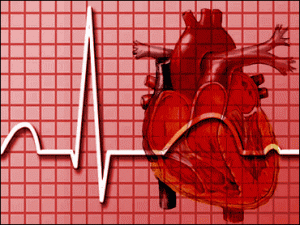 A hike in your blood pressure during middle age significantly raises the risk of having a heart attack or a stroke during your lifetime, according to new Northwestern Medicine research. The study offers a new understanding on the importance of maintaining low blood pressure early in middle age to prevent heart disease later in life. Men and women who developed high blood pressure in middle age or who started out with high blood pressure had an estimated 30 percent increased risk of having a heart attack or stroke compared to those who kept their blood pressure low.
A hike in your blood pressure during middle age significantly raises the risk of having a heart attack or a stroke during your lifetime, according to new Northwestern Medicine research. The study offers a new understanding on the importance of maintaining low blood pressure early in middle age to prevent heart disease later in life. Men and women who developed high blood pressure in middle age or who started out with high blood pressure had an estimated 30 percent increased risk of having a heart attack or stroke compared to those who kept their blood pressure low.
Previous estimates of a person’s risk of cardiovascular disease were based on a single blood pressure measurement. The higher the blood pressure reading, the greater the risk. The new Northwestern Medicine study expands on that by showing a more accurate predictor is a change in blood pressure from age 41 to 55.
“We found the longer we can prevent hypertension or postpone it, the lower the risk for cardiovascular disease,” said lead author Norrina Allen, assistant professor of preventive medicine at Northwestern University Feinberg School of Medicine. “Even for people with normal blood pressure, we want to make sure they keep it at that level, and it doesn’t start increasing over time.”
“There hasn’t been as much of a focus on keeping it low when people are in their 40’s and 50’s,” Allen added. “That’s before a lot of people start focusing on cardiovascular disease risk factors. We’ve shown it’s vital to start early.” People that maintain or reduce their blood pressure to normal levels by age 55 have the lowest lifetime risk for a heart attack or a stroke.
The study used data from 61,585 participants in the Cardiovascular Lifetime Risk Pooling Project. Starting with baseline blood pressure readings at age 41, researchers measured blood pressure again at age 55, then followed the patients until the occurrence of a first heart attack or stroke, death or age 95.
The study did include men and women demonstrating a growing increase in important sex based medicine. Men who developed high blood pressure in middle age or who started out with high blood pressure had a 70 percent risk of having a heart attack or stroke compared to a 41 percent risk for men who maintained low blood pressure or whose blood pressure decreased during the time period. Women who developed high blood pressure had almost a 50 percent risk of a heart attack or stroke compared to a 22 percent risk for those who kept their blood pressure low or saw a decrease.
Men generally have a 55 percent risk of cardiovascular disease in their lifetimes; women have a 40 percent risk.
“Our research suggests people can take preventive steps to keep their blood pressure low early on to reduce their chances of a heart attack or stroke,” said Donald M. Lloyd-Jones, MD, study co-author, chair of preventive medicine at Northwestern. “Maintaining a healthy diet, combined with exercise and weight control, can help reduce blood pressure levels and, consequently, your risk for cardiovascular disease later in life.”
The study is published in Circulation: Journal of the American Heart Association

 A hike in your blood pressure during middle age significantly raises the risk of having a heart attack or a stroke during your lifetime, according to new Northwestern Medicine research. The study offers a new understanding on the importance of maintaining low blood pressure early in middle age to prevent heart disease later in life. Men and women who developed high blood pressure in middle age or who started out with high blood pressure had an estimated 30 percent increased risk of having a heart attack or stroke compared to those who kept their blood pressure low.
A hike in your blood pressure during middle age significantly raises the risk of having a heart attack or a stroke during your lifetime, according to new Northwestern Medicine research. The study offers a new understanding on the importance of maintaining low blood pressure early in middle age to prevent heart disease later in life. Men and women who developed high blood pressure in middle age or who started out with high blood pressure had an estimated 30 percent increased risk of having a heart attack or stroke compared to those who kept their blood pressure low. Gender Differences in Blood Pressure Appears As Early As Adolescence, With Girls Faring Worse The female hormone estrogen is known to offer protection for the heart, but obesity may be taking away that edge in adolescent girls. New research from the University of California at Merced finds that although obesity does not help teens of either gender, it has a greater impact on girls’ blood pressure than it does on boys’. In a study of more than 1,700 adolescents between 13 and 17 years old, obese boys were 3.5 times more likely to develop elevated systolic blood pressure (SBP) than non-obese boys, but similarly obese girls were 9 times more likely to develop elevated systolic blood pressure than their non-obese peers. Systolic blood pressure, which is represented by the top number in a blood pressure reading, is the amount of force that blood exerts on blood vessel walls when the heart beats. High systolic measurements indicate risk for heart disease and stroke. Rudy M. Ortiz, PhD, Associate Professor of Physiology and Nutrition and his team obtained their data by direct measurements during the school district’s health surveys and physicals to assess the teenagers’ systolic blood pressure (SBP) against two health indicators: body mass index (BMI), which was categorized as normal weight, overweight, or obese, and blood pressure, which was categorized as normal, pre-elevated, or elevated. The researchers found that the teenagers’ mean BMI was significantly correlated with mean SPB for both sexes when both BMI and blood pressure assessments were used. They also found a significant correlation between BMI and SBP as a function of blood pressure, suggesting that the effect of body mass on SBP is much greater when it is assessed using blood pressure categories. “We were able to categorize the students in different ways, first based on BMI within each of three blood pressure categories. Then we flipped that around and looked at each category of blood pressure for different weight categories. In each case, we are looking at SBP as the dependent variable,” said Dr. Ortiz. An odds ratio analysis revealed that obese boys were 2 and 3.5 times more likely to develop pre-elevated and elevated SBP, respectively, than boys who were normal weight. Obese girls were 4 and 9 times more likely to develop pre-elevated and elevated SBP, respectively, than girls who were normal weight. According to Dr. Ortiz, the results do not bode well for obese teens later in life, especially for the girls. “Overall, there is a higher likelihood that those who present with both higher BMI and blood pressure will succumb to cardiovascular complications as adults. But the findings suggest that obese females may have a higher risk of developing these problems [than males].” As for why obesity has a greater impact on SBP in girls than in boys, Dr. Ortiz has a hunch. “This may be where physical activity comes into play. We know, for example, that obese adolescent females participate in 50 to 60% less physical activity than boys in the population surveyed.”
Gender Differences in Blood Pressure Appears As Early As Adolescence, With Girls Faring Worse The female hormone estrogen is known to offer protection for the heart, but obesity may be taking away that edge in adolescent girls. New research from the University of California at Merced finds that although obesity does not help teens of either gender, it has a greater impact on girls’ blood pressure than it does on boys’. In a study of more than 1,700 adolescents between 13 and 17 years old, obese boys were 3.5 times more likely to develop elevated systolic blood pressure (SBP) than non-obese boys, but similarly obese girls were 9 times more likely to develop elevated systolic blood pressure than their non-obese peers. Systolic blood pressure, which is represented by the top number in a blood pressure reading, is the amount of force that blood exerts on blood vessel walls when the heart beats. High systolic measurements indicate risk for heart disease and stroke. Rudy M. Ortiz, PhD, Associate Professor of Physiology and Nutrition and his team obtained their data by direct measurements during the school district’s health surveys and physicals to assess the teenagers’ systolic blood pressure (SBP) against two health indicators: body mass index (BMI), which was categorized as normal weight, overweight, or obese, and blood pressure, which was categorized as normal, pre-elevated, or elevated. The researchers found that the teenagers’ mean BMI was significantly correlated with mean SPB for both sexes when both BMI and blood pressure assessments were used. They also found a significant correlation between BMI and SBP as a function of blood pressure, suggesting that the effect of body mass on SBP is much greater when it is assessed using blood pressure categories. “We were able to categorize the students in different ways, first based on BMI within each of three blood pressure categories. Then we flipped that around and looked at each category of blood pressure for different weight categories. In each case, we are looking at SBP as the dependent variable,” said Dr. Ortiz. An odds ratio analysis revealed that obese boys were 2 and 3.5 times more likely to develop pre-elevated and elevated SBP, respectively, than boys who were normal weight. Obese girls were 4 and 9 times more likely to develop pre-elevated and elevated SBP, respectively, than girls who were normal weight. According to Dr. Ortiz, the results do not bode well for obese teens later in life, especially for the girls. “Overall, there is a higher likelihood that those who present with both higher BMI and blood pressure will succumb to cardiovascular complications as adults. But the findings suggest that obese females may have a higher risk of developing these problems [than males].” As for why obesity has a greater impact on SBP in girls than in boys, Dr. Ortiz has a hunch. “This may be where physical activity comes into play. We know, for example, that obese adolescent females participate in 50 to 60% less physical activity than boys in the population surveyed.”